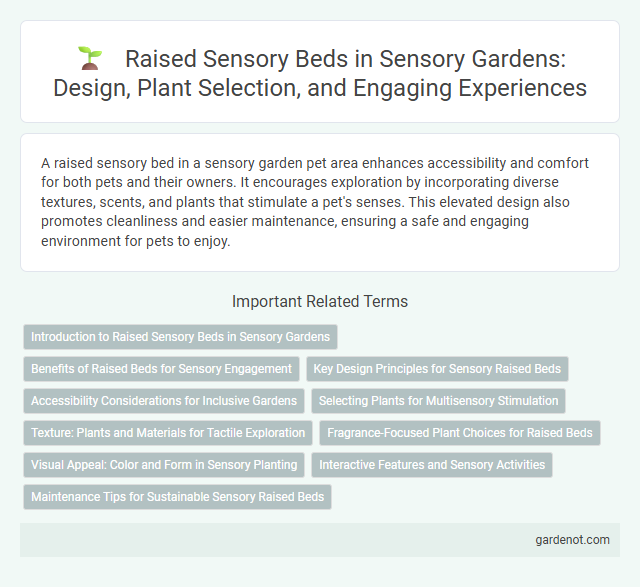A raised sensory bed in a sensory garden pet area enhances accessibility and comfort for both pets and their owners. It encourages exploration by incorporating diverse textures, scents, and plants that stimulate a pet's senses. This elevated design also promotes cleanliness and easier maintenance, ensuring a safe and engaging environment for pets to enjoy.
Introduction to Raised Sensory Beds in Sensory Gardens
Raised sensory beds in sensory gardens enhance accessibility and engagement for individuals with varying physical abilities, promoting interactive exploration through height-adjusted planting areas. These beds support diverse sensory experiences by incorporating plants with contrasting textures, vibrant colors, and aromatic qualities that stimulate touch, sight, and smell. Ergonomic design and thoughtful plant selection ensure an inclusive environment fostering therapeutic benefits and educational opportunities.
Benefits of Raised Beds for Sensory Engagement
Raised sensory beds enhance accessibility, allowing individuals of all abilities to comfortably explore diverse textures, scents, and colors. Elevated height reduces strain, promoting prolonged sensory interaction and engagement. These beds support better soil drainage and root health, ensuring vibrant plant growth that enriches the sensory experience.
Key Design Principles for Sensory Raised Beds
Raised sensory beds should incorporate varied textures, colors, and heights to stimulate multiple senses effectively. Using non-toxic, hypoallergenic plants and materials ensures safety and accessibility for all users, including those with disabilities. Proper drainage and ergonomic height design promote comfort and ease of maintenance while enhancing sensory engagement.
Accessibility Considerations for Inclusive Gardens
Raised sensory beds enhance accessibility by allowing individuals with mobility challenges to engage with the garden comfortably. These beds are designed at ergonomic heights to accommodate wheelchair users and those with limited bending ability, ensuring inclusivity. Incorporating tactile, aromatic, and visually stimulating plants within reach promotes equal sensory experiences for all visitors.
Selecting Plants for Multisensory Stimulation
Choosing plants for a raised sensory bed involves selecting species with diverse textures, scents, colors, and sounds to engage multiple senses simultaneously. Herbs like lavender and rosemary provide aromatic stimulation, while ornamental grasses produce soothing rustling sounds when moved by the wind. Incorporating tactile plants such as lamb's ear and fuzzy succulents enhances touch experiences, creating a rich, multisensory garden environment.
Texture: Plants and Materials for Tactile Exploration
Raised sensory beds enhance tactile exploration by incorporating plants with diverse textures such as lamb's ear, ornamental grasses, and succulents. Materials like smooth river stones, coarse bark mulch, and woven fabrics complement plant textures, providing varied sensory stimuli for touch. These combinations promote engagement and therapeutic benefits for all ages, especially in therapeutic and educational garden settings.
Fragrance-Focused Plant Choices for Raised Beds
Fragrance-focused plant choices for raised sensory garden beds include aromatic herbs such as lavender, rosemary, and thyme, which stimulate the olfactory senses. Incorporating fragrant flowers like jasmine, gardenia, and scented geraniums enhances the sensory experience by adding a variety of natural scents. Selecting these plants not only maximizes scent diffusion but also supports pollinators and complements the garden's overall therapeutic benefits.
Visual Appeal: Color and Form in Sensory Planting
Raised sensory beds amplify visual appeal by incorporating vibrant colors and diverse forms that stimulate the senses and enhance garden aesthetics. Selecting plants with contrasting foliage shapes, vivid blooms, and dynamic textures creates an engaging visual tapestry that supports sensory exploration. Integrating species such as purple coneflowers, variegated grasses, and colorful succulents elevates the sensory experience through striking color contrasts and sculptural forms.
Interactive Features and Sensory Activities
Raised sensory beds enhance accessibility by elevating plants and materials to a comfortable height, encouraging tactile exploration through a variety of textures such as soft moss, rough bark, and smooth stones. Interactive features like embedded sound elements, scented herbs, and color-contrasted foliage stimulate multiple senses simultaneously, fostering engagement for visitors of all ages. Sensory activities integrated into these beds, including plant identification, texture matching, and scent discovery, promote cognitive development and therapeutic relaxation in inclusive garden environments.
Maintenance Tips for Sustainable Sensory Raised Beds
Regularly monitor soil moisture levels in raised sensory beds to ensure optimal hydration without waterlogging, promoting healthy plant growth. Incorporate organic mulch such as shredded bark or compost around plants to retain moisture, suppress weeds, and enhance soil fertility. Schedule routine inspections for pests and diseases, using eco-friendly treatments to maintain a sustainable and thriving sensory garden environment.
Raised sensory bed Infographic

 gardenot.com
gardenot.com